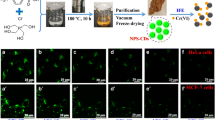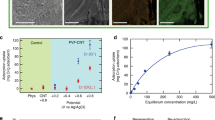Abstract
Water stands at the heart of the Sustainable Development Goals, and risk management for clean water often requires in situ monitoring of contaminants, where a portable photodetector with high detectivity is highly desired. The emerging portable organic photodetectors (OPDs) with intrinsic flexibility and light weight, which are promising candidates for in situ water pollution monitoring, often exhibit unsatisfactory specific detectivity (D*) lower than 1013 Jones, failing to meet monitoring requirements set below safety limits (~0.01–0.1 mg l−1) for pollutant discharge. Here we present OPDs with D* as high as 4.1 × 1013 Jones made from dense and ordered polymer films via colloid processing, attributed to their substantially lower energy disorder and fewer traps than those deposited via traditional solution processing. Detectable light intensities as weak as approaching 0.1 pW cm−2 of colloid-processed OPDs (CP-OPDs) at visible to near-infra-red light are achieved, on par with the premium commercial Si photodiode and overwhelming some widely used models. Highly sensitive and accurate monitoring of trace dye pollutants/chlorophyllin A analogue in water with a detection limit of 0.02/0.05 mg l−1 (below the discharge/eutrophication standard) is successfully accomplished through the developed CP-OPDs, surpassing the commercial Si photodiode that cannot effectively respond to the concentration below the standard. Colloid processing endows OPDs with the highest detectivity among reported portable photodetectors and makes CP-OPDs superior in in situ monitoring trace contaminants in water relative to traditional methods.





Similar content being viewed by others
Data availability
All data needed to evaluate the conclusions in the paper are present in the paper and/or Supplementary Information. The data that support the findings of this study and the raw data for all the figures have been uploaded to Figshare (https://doi.org/10.6084/m9.figshare.25470085).
References
The Sustainable Development Goals Report (2022). United Nations https://unstats.Un.Org/sdgs/report/2022/ (2023).
Vörösmarty, C. J. et al. Global threats to human water security and river biodiversity. Nature 467, 555–561 (2010).
Turner, S. W. D. et al. Comparison of potential drinking water source contamination across one hundred U.S. cities. Nat. Commun. 12, 7254 (2021).
Lin, J. et al. Environmental impacts and remediation of dye-containing wastewater. Nat. Rev. Earth Environ. 4, 785–803 (2023).
Maity, A. et al. Scalable graphene sensor array for real-time toxins monitoring in flowing water. Nat. Commun. 14, 4184 (2023).
Jung, J. K. et al. Cell-free biosensors for rapid detection of water contaminants. Nat. Biotechnol. 38, 1451–1459 (2020).
García de Arquer, F. P., Armin, A., Meredith, P. & Sargent, E. H. Solution-processed semiconductors for next-generation photodetectors. Nat. Rev. Mater. 2, 16100 (2017).
Wang, H. & Kim, D. H. Perovskite-based photodetectors: materials and devices. Chem. Soc. Rev. 46, 5204–5236 (2017).
Jiang, J. et al. Synergistic strain engineering of perovskite single crystals for highly stable and sensitive X-ray detectors with low-bias imaging and monitoring. Nat. Photon. 16, 575–581 (2022).
Pan, W. et al. Cs2AgBiBr6 single-crystal X-ray detectors with a low detection limit. Nat. Photon. 11, 726–732 (2017).
Rauch, T. et al. Near-infrared imaging with quantum-dot-sensitized organic photodiodes. Nat. Photon. 3, 332–336 (2009).
Jaehyun, K. et al. A skin-like two-dimensionally pixelized full-color quantum dot photodetector. Sci. Adv. 5, eaax8801 (2019).
Zhang, G. et al. Renewed prospects for organic photovoltaics. Chem. Rev. 122, 14180–14274 (2022).
Yao, H. et al. Molecular design of benzodithiophene-based organic photovoltaic materials. Chem. Rev. 116, 7397–7457 (2016).
Wang, J. et al. The principles, design and applications of fused-ring electron acceptors. Nat. Rev. Chem. 6, 614–634 (2022).
Wei, Y. et al. Self‐powered organic photodetectors with high detectivity for near infrared light detection enabled by dark current reduction. Adv. Funct. Mater. 31, 2106326 (2021).
Wu, Z. et al. Noise and detectivity limits in organic shortwave infrared photodiodes with low disorder. npj Flex. Electron. 4, 6 (2020).
Sandberg, O. J. et al. Mid-gap trap state-mediated dark current in organic photodiodes. Nat. Photon. 17, 368–374 (2023).
Canek, F.-H. et al. Large-area low-noise flexible organic photodiodes for detecting faint visible light. Science 370, 698–701 (2020).
Discharge standards of water pollutants for dyeing and finishing of textile industry. Ministry of Ecology and Environment of the People’s Republic of China https://www.mee.gov.cn/ywgz/fgbz/bz/bzwb/shjbh/swrwpfbz/201211/t20121109_241788.htm (2012).
Kuik, M. et al. 25th anniversary article: charge transport and recombination in polymer light-emitting diodes. Adv. Mater. 26, 512–531 (2014).
Kronemeijer, A. J. et al. Two-dimensional carrier distribution in top-gate polymer field-effect transistors: correlation between width of density of localized states and Urbach energy. Adv. Mater. 26, 728–733 (2014).
Nikolka, M. et al. High-mobility, trap-free charge transport in conjugated polymer diodes. Nat. Commun. 10, 2122 (2019).
Yan, X. et al. Approaching disorder-tolerant semiconducting polymers. Nat. Commun. 12, 5723 (2021).
Bharti, V. et al. Improved hole mobility and suppressed trap density in polymer-polymer dual donor based highly efficient organic solar cells. Appl. Phys. Lett. 108, 073505 (2016).
Lim, J. A. et al. Polymer semiconductor crystals. Mater. Today 13, 14–24 (2010).
Sneyd, A. J. et al. Efficient energy transport in an organic semiconductor mediated by transient exciton delocalization. Sci. Adv. 7, eabh4232 (2021).
Liu, S. et al. High-efficiency organic solar cells with low non-radiative recombination loss and low energetic disorder. Nat. Photon. 14, 300–305 (2020).
Gong, W. et al. Influence of energetic disorder on electroluminescence emission in polymer:fullerene solar cells. Phys. Rev. B 86, 024201 (2012).
Verploegen, E. et al. Effects of thermal annealing upon the morphology of polymer-fullerene blends. Adv. Funct. Mater. 20, 3519–3529 (2010).
Walter, T., Herberholz, R., Müller, C. & Schock, H. W. Determination of defect distributions from admittance measurements and application to Cu(In,Ga)Se2 based heterojunctions. J. Appl. Phys. 80, 4411–4420 (1996).
Shao, Y. et al. Origin and elimination of photocurrent hysteresis by fullerene passivation in CH3NH3PbI3 planar heterojunction solar cells. Nat. Commun. 5, 5784 (2014).
Malliaras, G. G., Salem, J. R., Brock, P. J. & Scott, C. Electrical characteristics and efficiency of single-layer organic light-emitting diodes. Phys. Rev. B 58, R13411–R13414 (1998).
Smilgies, D.-M. Scherrer grain-size analysis adapted to grazing-incidence scattering with area detectors. Erratum. J. Appl. Crystallogr. 46, 286–286 (2013).
Cheng, P. et al. Diluting concentrated solution: a general, simple and effective approach to enhance efficiency of polymer solar cells. Energy Environ. Sci. 8, 2357–2364 (2015).
Zhao, X. et al. Antisolvent-assisted controllable growth of fullerene single crystal microwires for organic field effect transistors and photodetectors. Nanoscale 10, 8170–8179 (2018).
Yao, Z. F. et al. Wafer-scale fabrication of high-performance n-type polymer monolayer transistors using a multi-level self-assembly strategy. Adv. Mater. 31, e1806747 (2019).
Haneef, H. F., Zeidell, A. M. & Jurchescu, O. D. Charge carrier traps in organic semiconductors: a review on the underlying physics and impact on electronic devices. J. Mater. Chem. C 8, 759–787 (2020).
Ugur, E. et al. Life on the Urbach edge. J. Phys. Chem. Lett. 13, 7702–7711 (2022).
Liu, T. et al. Near infrared self‐powered organic photodetectors with a record responsivity enabled by low trap density. Adv. Funct. Mater. 33, 2301167 (2023).
**ong, S. et al. Universal strategy to reduce noise current for sensitive organic photodetectors. ACS Appl. Mater. Interfaces 9, 9176–9183 (2017).
Kim, T.-H. et al. Full-colour quantum dot displays fabricated by transfer printing. Nat. Photon. 5, 176–182 (2011).
Fang, Y., Armin, A., Meredith, P. & Huang, J. Accurate characterization of next-generation thin-film photodetectors. Nat. Photon. 13, 1–4 (2019).
Tumbleston, J. R. et al. The influence of molecular orientation on organic bulk heterojunction solar cells. Nat. Photon. 8, 385–391 (2014).
Yuan, J. et al. Single-junction organic solar cell with over 15% efficiency using fused-ring acceptor with electron-deficient core. Joule 3, 1140–1151 (2019).
Sajjad, M. T., Ruseckas, A. & Samuel, I. D. W. Enhancing exciton diffusion length provides new opportunities for organic photovoltaics. Matter 3, 341–354 (2020).
Product page of FDS100. Thorlabs https://www.thorlabs.us/thorProduct.cfm?partNumber=FDS100 (2017).
Product page of DSi200. Zolix https://www.zolix.com.cn/prodcon_370_379_387.html (2018).
Datasheet of Si photodiode S1336 series. Hamamatsu https://www.hamamatsu.com.cn/content/dam/hamamatsu-photonics/sites/documents/99_SALES_LIBRARY/ssd/s1336_series_kspd1022e.pdf (2023).
Kaiser, C. et al. A universal Urbach rule for disordered organic semiconductors. Nat. Commun. 12, 3988 (2021).
Bisquert, J. Interpretation of electron diffusion coefficient in organic and inorganic semiconductors with broad distributions of states. Phys. Chem. Chem. Phys. 10, 3175–3194 (2008).
Pomerantz, Z. et al. Capacitance, spectroelectrochemistry and conductivity of polarons and bipolarons in a polydicarbazole based conducting polymer. J. Electroanal. Chem. 614, 49–60 (2008).
Shao, Y., Yuan, Y. & Huang, J. Correlation of energy disorder and open-circuit voltage in hybrid perovskite solar cells. Nat. Energy 1, 15001 (2016).
Heath, J. T., Cohen, J. D. & Shafarman, W. N. Bulk and metastable defects in CuIn1−xGaxSe2 thin films using drive-level capacitance profiling. J. Appl. Phys. 95, 1000–1010 (2004).
Liu, J. et al. Challenges and recent advances in photodiodes-based organic photodetectors. Mater. Today 51, 475–503 (2021).
Oba, T. et al. Spectral characteristics and colloidal properties of chlorophyll a′ in aqueous methanol. J. Phys. Chem. B 101, 3261–3268 (1997).
Water quality—determination of auiline compounds—spectrophotometric method with N-(1-naphthyl)echylenediamine. Ministry of Ecology and Environment of the People’s Republic of China https://www.mee.gov.cn/ywgz/fgbz/bz/bzwb/jcffbz/199007/t19900701_67185.shtml (1990).
Yang, X.-E., Wu, X., Hao, H.-l & He, Z.-l Mechanisms and assessment of water eutrophication. J. Zhejiang Univ. Sci. B 9, 197–209 (2008).
Zhong, Z. et al. Ternary organic photodiodes with spectral response from 300 to 1200 nm for spectrometer application. Sci. China Mater. 64, 2430–2438 (2021).
Li, T. et al. Sensitive photodetection below silicon bandgap using quinoid-capped organic semiconductors. Sci. Adv. 9, eadf6152 (2023).
Acknowledgements
We thank the financial support from the Strategic Priority Research Program of the Chinese Academy of Sciences (XDB0520102) (Y. Lin), the National Natural Science Foundation of China (22105208) (T.L.), and the Bei**g Natural Science Foundation (2232075) (Y. Lin).
Author information
Authors and Affiliations
Contributions
Y. Lin conceived the idea, designed the experiments and supervised the project. T.L. fabricated and characterized the OPD devices and carried out the measurements of TEM, noise current, FTPS-EQE, tDOS, space-charge limited current and DLCP. G.H. and L.S. conducted the measurements of response time and cut-off frequency and performed the application of water pollution monitoring. H.W. and Y.Q. supplied and optimized the method of colloid preparation and carried out the TEM measurement. L.D. and Y.F. conducted the NEP and LDR measurements. M.S. and Y.S. performed the electron DOS measurement. J.Z. carried out the GIWAXS measurement. Y. Li conducted the AFM measurement. Z.L. assisted in the measurement of DLCP. Y. Lin and T.L. wrote the manuscript. All authors reviewed this paper.
Corresponding authors
Ethics declarations
Competing interests
The authors declare no competing interests.
Peer review
Peer review information
Nature Water thanks Nicola Gasparini and the other, anonymous, reviewer(s) for their contribution to the peer review of this work.
Additional information
Publisher’s note Springer Nature remains neutral with regard to jurisdictional claims in published maps and institutional affiliations.
Supplementary information
Supplementary Information
Supplementary text, Figs. 1–20 and Tables 1–3.
Rights and permissions
Springer Nature or its licensor (e.g. a society or other partner) holds exclusive rights to this article under a publishing agreement with the author(s) or other rightsholder(s); author self-archiving of the accepted manuscript version of this article is solely governed by the terms of such publishing agreement and applicable law.
About this article
Cite this article
Li, T., Hu, G., Wu, H. et al. Highly sensitive water pollution monitoring using colloid-processed organic photodetectors. Nat Water 2, 577–588 (2024). https://doi.org/10.1038/s44221-024-00247-0
Received:
Accepted:
Published:
Issue Date:
DOI: https://doi.org/10.1038/s44221-024-00247-0
- Springer Nature Limited





